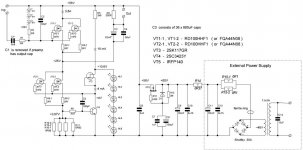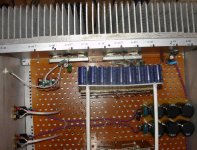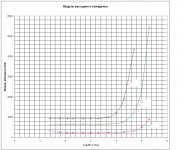I have put into service pure class A amp based on the following schematics. Assembled point-to-point, sound is amasing. Gives impression of a "direct wire". I compare it with SE 300B based amp. Similar sound transparency, but overall is better.
I understand real problem with getting RD100HHF1 transistors, but I gues other good ones will go.
I understand real problem with getting RD100HHF1 transistors, but I gues other good ones will go.
Attachments
Can VT3 be substituted with 2SK170BL? And VT1/VT2 with equivalents from Fairchild? I am asking since I may be able to try these with substitute parts. Thanks.
Can VT3 be substituted with 2SK170BL? And VT1/VT2 with equivalents from Fairchild? I am asking since I may be able to try these with substitute parts. Thanks.
Yes, VT3 can be 2SK170BL or 2SK170GR, and VT1, VT2 - any decent MOSFETs, 44N08 or K1529, K1530.
Most of all sound affected by the output cap design (I used Jamicon WG series, but Panasonic FM 1000uF could be even better), and big polypropylene shunt is obligatory.
Be shure, sound will pleasantly surprise you.
One possible difficulty will be a good preamp, tube one with no less than 20dB amplification will fit.
My solution for preamp I posted at Pass forum
http://www.diyaudio.com/forums/pass-labs/145303-50w-version-zen9-7.html#post2424293
Last edited:
Sorry I forgot to ask earlier but how tight and articulate is the bass; mids and highs should be as good as tubes, from your report.
Sorry I forgot to ask earlier but how tight and articulate is the bass; mids and highs should be as good as tubes, from your report.
In my system, with the preamp indicated above (NO NFB single-ended stage) and the present Follower, as a result I have NO NFB system with output impedance nearly 0,2 Ohms. Believe, 0,2 without NFB makes much better bass than 0,2 Ohms emulated by NFB, there is some specific artefacts induced by the speaker back EMF. For comparison, impedance of my High-End Stereovox speaker cable is near 0,4 Ohms.
With 50W Zen9 bass is also good with Aleph CS being active, but without it, the highs are close (almost) to the Follower, but the bass of Follower is noticably better.
I have measured frequency dependent output impedance of this follower (mOhms on the vertical axis, and Log10 F(Hz) on the horizontal), and also of two modifications of 50W Zen9.
Curve 1 - present follower
Curve 2 - 50W Zen9 with increased NFB, voltage amplification near factor 2, without current source modulation
Curve 3 - 50W Zen9 with standard amplification factor 5, current source modulation is active
Variants 1 and 2 are close in middles and highs reproduction, but the bass is the best with follower
Curve 1 - present follower
Curve 2 - 50W Zen9 with increased NFB, voltage amplification near factor 2, without current source modulation
Curve 3 - 50W Zen9 with standard amplification factor 5, current source modulation is active
Variants 1 and 2 are close in middles and highs reproduction, but the bass is the best with follower
Attachments
Are V1-V3 9v zener diodes? And are HL1-HL6 LEDs (what colour, voltage drop)? 1KVA transformer! What concessions can be made in this costly component? It will be nice if you can make a full bill of materials, indicating modern alternatives. Thanks.
Wow, what a wonderful mosfet the RD100 is! But I can't see circuit improvement that will solve the 99-Follower's problem if ordinary IRF mosfet is used.
How come this RD100 is not popular? (at least unknown to me)
How come this RD100 is not popular? (at least unknown to me)
Are V1-V3 9v zener diodes? And are HL1-HL6 LEDs (what colour, voltage drop)? 1KVA transformer! What concessions can be made in this costly component? It will be nice if you can make a full bill of materials, indicating modern alternatives. Thanks.
V1-V3 are the 9V batteries used for home appliance, they produced so call battery bias, that is used sometime in tube schematics and also in some high-end solid-state amplifies. It produces quietest bias for the sensitive points, among all possible. An alternative to it will be usual resistor divider with an electrolytic cap, which I try to avoid everywere if possible.
HL1-HL6 are the red light diodes, with near 1,8V voltage drop on each. They represent simplest, but extremely fast and low noise shunt power supply for VT3-VT4. As yuo not, I do not use here electrolytics as well.
Using VT3 instead of resistor, makes CCS composed by VT2-VT4 more close to an ideal one.
1KVA transformer looks like a joke, but I have not managed to avoid electro-mechanical trafo bussing with smaller ones, since my aim was an absolutely pure backgroung. If you manage to avoid buzzing under 4A load with smaller trafo, that will be your benefit.
Wow, what a wonderful mosfet the RD100 is! But I can't see circuit improvement that will solve the 99-Follower's problem if ordinary IRF mosfet is used.
How come this RD100 is not popular? (at least unknown to me)
Were are many wonderful MOSFETs by NXP, used in avionics and wireless communication equipment.
RD100 is one of the cheapest and most affordable. With this schematics, I tried to answer for myself, is it possible to get close to SE tube sound with SS schematics. An answer is yes, it is possible in MF and HF range, and better in bass range. But one must pay a price for it - an expensive low-capacitance MOSFETs, expensive capacitors, expensive heatsinks, NO signal current thriugh PS electrolytics. In this approach, one can forget speculations about difference of "electrons in vacuum" or "electrons in SS". Tubes are much better than ordinary MOSFETs because of orders of magnitude smaller parasitic capacitances, and using of good signal transformers. SS world has an adequate answer to it, just one must not be afraid.
Vladimir,
very nice amp.
But: the signal does go through all parts, including the PS electrolytics and the nonlinear noisy diodes. The controlling voltages should be more appropriately applied between the gate and source.
What are the dynamic capacitances of RD100HHF1?
What has NXP to do with the RD100HHF1?
very nice amp.
But: the signal does go through all parts, including the PS electrolytics and the nonlinear noisy diodes. The controlling voltages should be more appropriately applied between the gate and source.
What are the dynamic capacitances of RD100HHF1?
What has NXP to do with the RD100HHF1?
Last edited:
Vladimir, very nice amp.
But: the signal does go through all parts, including the PS electrolytics and the nonlinear noisy diodes. The controlling voltages should be more appropriately applied between the gate and source.
What are the dynamic capacitances of RD100HHF1?
What has NXP to do with the RD100HHF1?
Please, understand, there is nothing absolute in this world, and saying that signal goes or does not go through definite point in the schematics we have in mind some relative things. Trying to introduce absolutely correct definitions, we could spend a whole life for it, but this does not make us closer to a good sound. You might want to read Andrea's paper on the Follower-99, where he explained why otput signal does not go through PS.
RD100HHF1 specs we can see from Mitsubisi datasheets, of course, it is not by NXP, but those from NXP (trench-MOSFETs) are better than this one and cost 200...500 EUR per piece.
One more IMHO: those schematics characteristics, that we frequently believe very important for sound perception, in fact are not. I would always prefer simpler solution if it is about trade between 0,001% and 0,01% THD, and try to avoid electrolytics everywere it is possible.
Last edited:
Fantastic circuit, Vladimir, hats off.....
Thanks, but this was mainly Anrea Ciuffolli idea.
Yes, I know that, perhaps I should have said very nice implementation....
Greetings to cancer ward....
Hugh
Greetings to cancer ward....
Hugh
Yes, I know that, perhaps I should have said very nice implementation.... Greetings to cancer ward.... Hugh
With this implementation I have tried to compete with 300B SE tube amp, that I have bought for having a reference. I can say, the target is almost achieved. Some recordings are better with the follower (I mean mids and highs, the lows are always better with follower), some (only few) are still I would prefer with 300B.
RD100HHF1 specs we can see from Mitsubisi datasheets, of course, it is not by NXP, but those from NXP (trench-MOSFETs) are better than this one and cost 200...500 EUR per piece.
My! I didn't know a transistor can be that expensive! May be the Mitsubishi one is a lot cheaper? If below 40 EUR every audiophile should build this amp!
My! I didn't know a transistor can be that expensive! May be the Mitsubishi one is a lot cheaper? If below 40 EUR every audiophile should build this amp!
I was lucky to buy 16pcs of RD100 for 47 USD/pcs, this fit your criterion, and again, due to some luck, I was able to select four matched pairs.
Dont know how it is in S-E Asia, but in Europe they are overpriced, nearly 100 EUR/pcs as per Google.
Another difficulty, preamp with large enough voltage swing and amplification is needed. I guess, it does not cause problem for tube designs.
But my transistor solution for preamp (100V Power Supply rail) also sounds excellently.
Great work. For additional enhancing the sound quality replace the capacitor clusters (consist of a large amound of small and cheap caps) through top class capacitors from rifa/kemet or FTcapHere are some fotos of the Follower, point-to-point soldering
http://www.kemet.com/kemet/web/homepage/kechome.nsf/weben/40CE1038519E7D68852576AE00824F64/$file/F3304_ALS42_43.pdf
Electrolytic capacitor with screw terminals - FTCap Fischer & Tausche Capacitors Group
read in this case follow thread carefully:
http://www.diyaudio.com/forums/parts/151392-best-electrolytic-capacitors.html
- Status
- Not open for further replies.
- Home
- Amplifiers
- Solid State
- Modified Follower-99 With HF Transistors




